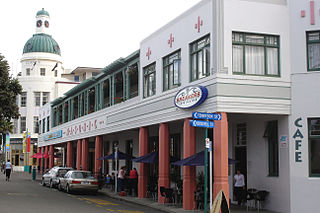
Hawke's Bay is a region on the east coast of New Zealand's North Island. The region is named for Hawke Bay, which was named in honour of Edward Hawke. The region's main centres are the cities of Napier and Hastings, while the more rural parts of the region are served by the towns of Waipukurau, Waipawa, and Wairoa.

Napier is a city on the eastern coast of the North Island of New Zealand and the seat of the Hawke's Bay region. It is a beachside city with a seaport, known for its sunny climate, esplanade lined with Norfolk pines, and extensive Art Deco architecture. Napier is sometimes referred to as the "Nice of the Pacific", although that is largely outdated and a more common nickname is 'The Art Deco Capital of the world'.

The 1931 Hawke's Bay earthquake, also known as the Napier earthquake, occurred in New Zealand at 10:47 am on 3 February, killing 256, injuring thousands and devastating the Hawke's Bay region. It remains New Zealand's deadliest natural disaster. Centred 15 km north of Napier, it lasted for two and a half minutes and had a magnitude of 7.8 . There were 525 aftershocks recorded in the following two weeks, with 597 being recorded by the end of February. The main shock could be felt in much of New Zealand, with reliable reports coming in from as far south as Timaru, on the east coast of the South Island.

Hastings is an inland city of New Zealand and is one of the two major urban areas in Hawke's Bay, on the east coast of the North Island. The population of Hastings is 51,500, with a further 15,200 people in Havelock North and 2,090 in Clive. Hastings is about 18 kilometres inland of the coastal city of Napier. These two neighbouring cities are often called "The Bay Cities" or "The Twin Cities".
Waipukurau is the largest town in the Central Hawke's Bay District on the east coast of the North Island of New Zealand. It is located on the banks of the Tukituki River, 7 kilometres south of Waipawa and 50 kilometres southwest of Hastings.

Wairoa is the largest town in the Wairoa District and the northernmost town in the Hawke's Bay region of New Zealand's North Island. It is located on the northern shore of Hawke Bay at the mouth of the Wairoa River and to the west of Māhia Peninsula. It is 118 kilometres (73 mi) northeast of Napier, and 92 kilometres (57 mi) southwest of Gisborne, on State Highway 2. It is the nearest town to the Te Urewera protected area and former national park, which is accessible from Wairoa via State Highway 38. It is one of three towns in New Zealand where Māori outnumber other ethnicities, with 62.29% of the population identifying as Māori.

Napier Hill is a limestone outcrop and suburb rising above the lowland districts of the city of Napier on New Zealand's North Island.

Hawke's Bay Airport, commonly referred to as Napier Airport, is Hawke's Bay's main commercial airport, serving domestic flights to the main centres of Auckland, Wellington and Christchurch, and smaller centres such as Gisborne. The airport is located in the north of Napier and 20.7 km from Hastings.
Napier Boys' High School is a secondary boys' school in, Napier, New Zealand. It currently has a school roll of approximately 1,321 pupils. The school provides education from Year 9 to Year 13.

Napier is a New Zealand parliamentary electorate, returning one Member of Parliament to the House of Representatives. It is named after the city of Napier, the main urban area within the electorate. The electorate was established for the 1861 election and has existed since. It has been held by Katie Nimon of the New Zealand National Party since the 2023 general election. It was held by Stuart Nash of the New Zealand Labour Party from the 2014 general election until 2023, when he did not stand for re-election.
Napier Girls' High School is a state secondary school on Clyde Road, Napier, New Zealand. It is one of the oldest schools in New Zealand for girls, and has a current school roll of about 1000.
St. John's College is a State Integrated, Catholic, Day School for boys, located in Hastings, a provincial city in Hawkes Bay, New Zealand.
William Arthur Greener Penlington was a New Zealand school principal and educationalist.
The Hawke's Bay Herald-Tribune was a New Zealand newspaper which published from 1937 until 1999. Covering the Hawke's Bay region, it was based in Hastings.

Jas J Niven & Co Limited later Niven Engineering, was a New Zealand engineering business based in Wellington with operations throughout the country. The foundry that became Niven's business was established in Napier in 1866.
Te Awa is a suburb of the city of Napier, in the Hawke's Bay region of New Zealand's eastern North Island.
Zarn Sullivan is a New Zealand rugby union player, who currently plays as a fullback or fly-half for the Blues in Super Rugby and for Auckland in New Zealand's domestic National Provincial Championship competition.

Roland Hipkins (1894–1951) was an English artist who worked extensively in New Zealand between 1922 and 1951. He is especially noted for his work done in the wake of the 1931 Hawke's Bay earthquake. Works by Hipkins are held by the Hawkes Bay Cultural Trust, the Royal College of Art in London, and the Sarjeant Art Gallery in Wanganui.
Tyrone Thompson is a New Zealand rugby union player, who plays as a hooker for Hawke's Bay in New Zealand's domestic National Provincial Championship competition and the Chiefs in Super Rugby.
Lincoln McClutchie is a New Zealand rugby union player, who currently plays as a first five-eighth for Hawke's Bay in New Zealand's domestic National Provincial Championship competition and San Diego Legion in Major League Rugby.














